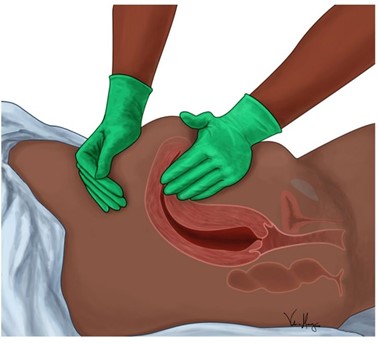On the first day after a cesarean section, a client who is a primipara is being assisted to the bathroom for the first time. The client experiences a sudden gush of vaginal blood and notices that several blood clots are in the toilet. Which action should the practical nurse (PN) take?
Insert an indwelling catheter to empty the bladder and contract the fundus.
Check fundal consistency and continue to monitor the lochial flow amount.
Return the client to bed and maintain bedrest until the lochial flow slows.
Massage the fundus and avoid direct pressure on the cesarean incision.
The Correct Answer is D
This is the best action to take for a client who experiences a sudden gush of vaginal blood and clots after a cesarean section. Massaging the fundus helps to stimulate uterine contractions and reduce bleeding. Avoiding direct pressure on the incision prevents pain and wound dehiscence.

Nursing Test Bank
Naxlex Comprehensive Predictor Exams
Related Questions
Correct Answer is ["C","D","E"]
Explanation
Prior to administering pain medication to an adult postoperative client, the practical nurse (PN) should obtain the following information:
- Time of last administration of pain medication: It is important to know when the client last received pain medication to ensure that the appropriate timing for the next dose is followed.
- Client's pain rating on a scale of 1 to 10: Assessing the client's current pain level helps determine the need for pain medication and the appropriate dose.
- Effectiveness of last pain medication administered: Evaluating the effectiveness of the previous pain medication helps determine if the current regimen is sufficient or if adjustments need to be made.
Obtaining the height and weight of the client prior to admission and the history of pain medication use during the past year may not be directly relevant to the immediate administration of pain medication.
Correct Answer is A
Explanation
- A terminally ill client is a client who has a progressive and incurable disease or condition that is expected to result in death within a short period of time, such as months or weeks. A terminally ill client may require palliative care, which is the care that focuses on relieving pain and suffering and improving the quality of life for the client and their family.
- An admission assessment is the process of collecting information about a client's health status, needs, preferences, and goals when they are admitted to a health care facility, such as a hospital, nursing home, or hospice. An admission assessment helps to establish a baseline for the client's condition, plan and implement appropriate interventions, and evaluate the outcomes of care.
- A health care proxy is a legal document that allows a client to appoint another person, such as a family member or a friend, to make health care decisions for them if they become unable to do so themselves. A health care proxy may also include specific instructions or preferences about the type and extent of care that the client wishes to receive or refuse, such as life-sustaining treatments, resuscitation, or organ donation.
- Health care proxy documentation is important information that the practical nurse (PN) should collect during the admission assessment of a terminally ill client to an acute care facility, as it reflects the client's autonomy, dignity, and wishes regarding their end-of-life care. It also helps to ensure that the client's healthcare decisions are respected and followed by the healthcare team and the facility.
- Therefore, option A is the correct answer, while options B, C, and D are incorrect.
Whether you are a student looking to ace your exams or a practicing nurse seeking to enhance your expertise , our nursing education contents will empower you with the confidence and competence to make a difference in the lives of patients and become a respected leader in the healthcare field.
Visit Naxlex, invest in your future and unlock endless possibilities with our unparalleled nursing education contents today
Report Wrong Answer on the Current Question
Do you disagree with the answer? If yes, what is your expected answer? Explain.
Kindly be descriptive with the issue you are facing.
